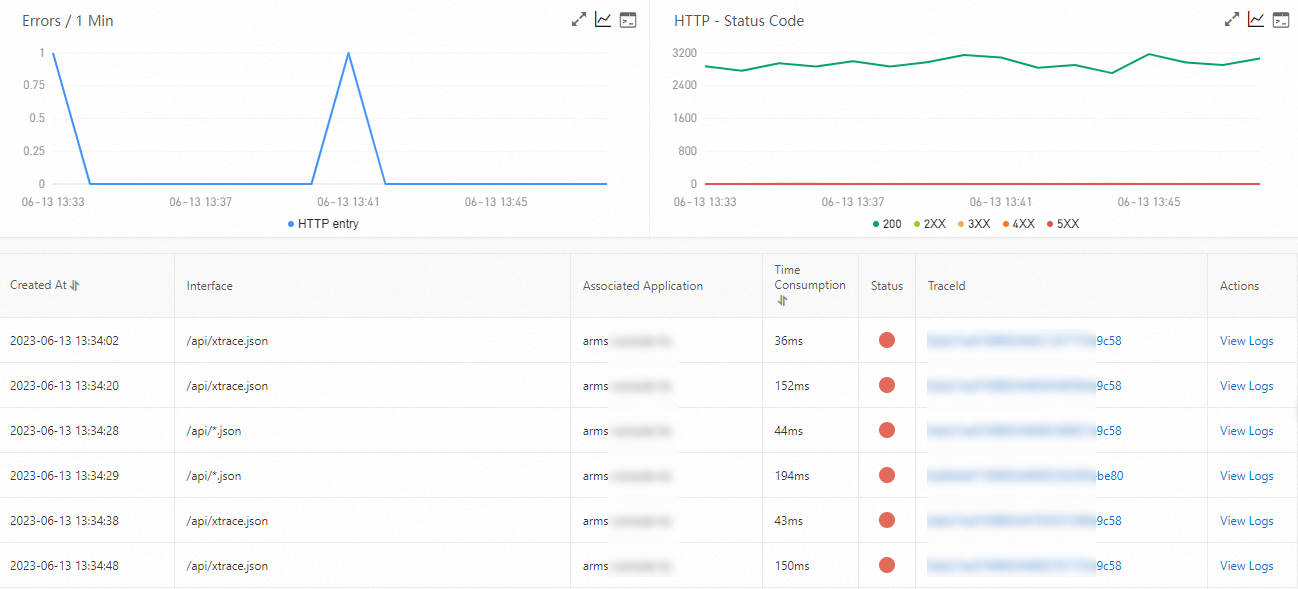This topic describes how to view the error analysis details of an application.
Criteria
The error analysis feature of Application Real-Time Monitoring Service (ARMS) helps you analyze errors. If an error occurs when an interface is called, an error message is returned. The following information indicates an error:
For HTTP requests, HTTP status codes greater than 400 are returned.
You can configure filter conditions to exclude specific HTTP status codes on the Custom Configuration tab of the Application Settings page. Then, the error analysis feature will ignore these HTTP status codes.
Generally, if the try...catch statement fails to detect exceptions, explicit error information is returned.
Prerequisites
The application is monitored by Application Monitoring. For more information, see Overview.
Procedure
Log on to the ARMS console. In the left-side navigation pane, choose .
On the Applications page, select a region in the top navigation bar and click the name of the application that you want to manage.
NoteIf the
 icon is displayed in the Language column, the application is connected to Application Monitoring. If a hyphen (-) is displayed, the application is connected to Managed Service for OpenTelemetry .
icon is displayed in the Language column, the application is connected to Application Monitoring. If a hyphen (-) is displayed, the application is connected to Managed Service for OpenTelemetry .In the left-side navigation pane, click Application Details.
On the Application Details page, select an application instance, set the time period, and then click the Error Analysis tab.

Number of errors
In the Errors section, a time series curve indicates the number of errors of the application in the specified time period.
Optional: In the Errors section, you can perform the following operations:
- Move the pointer over a chart and view the detailed statistics.
- Use the cursor to select a time period to view the statistics of the specified time period.
- Click the
 icon to view the statistics of the metric in a certain time period or compare the statistics of the metric in the same time period on different dates.
icon to view the statistics of the metric in a certain time period or compare the statistics of the metric in the same time period on different dates. - Click the
 icon to view the API details of the metric.
icon to view the API details of the metric.
HTTP status codes
The HTTP - Status Code section displays the time series curve that indicates the HTTP status code statistics of the application in the specified time period.
Optional: In the HTTP - Status Code section, you can perform the following operations:
- Move the pointer over a chart and view the detailed statistics.
- Use the cursor to select a time period to view the statistics of the specified time period.
- Click the legend to hide or show the data.
- Click the
 icon to view the statistics of the metric in a certain time period or compare the statistics of the metric in the same time period on different dates.
icon to view the statistics of the metric in a certain time period or compare the statistics of the metric in the same time period on different dates. - Click the
 icon to view the API details of the metric.
icon to view the API details of the metric.
Error list
The error list displays all errors of the application in the specified time period.
Optional: In the error list, you can perform the following operations:
To view a trace of an error, click the trace ID in the TraceId column. For more information, see Trace query.
To view the logs of an error, click View Logs in the Actions column.
NoteYou must associate trace IDs with the business logs of an application. This way, when an error occurs in the application, you can access the business logs that are associated with trace IDs to troubleshoot the error. For more information, see Associate trace IDs with business logs.